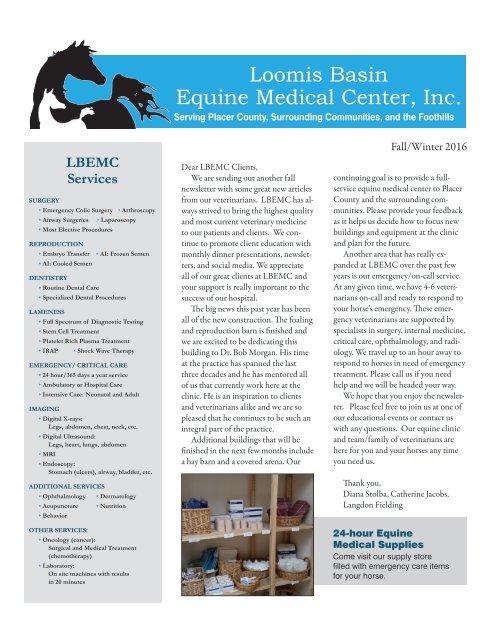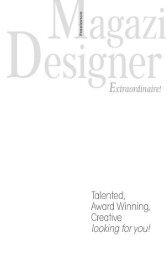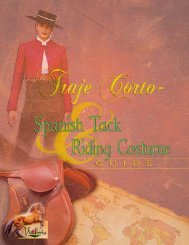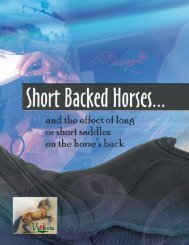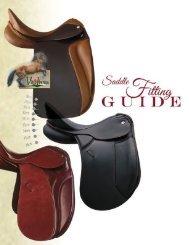LBEMC Newsletter FallWinter2015
Annual 2016 Fall/Winter newsletter produced by the Loomis Basin Equine Medical Center of Penryn, CA.
Annual 2016 Fall/Winter newsletter produced by the Loomis Basin Equine Medical Center of Penryn, CA.
You also want an ePaper? Increase the reach of your titles
YUMPU automatically turns print PDFs into web optimized ePapers that Google loves.
Loomis Basin<br />
Equine Medical Center, Inc.<br />
Serving Placer County, Surrounding Communities, and the Foothills<br />
<strong>LBEMC</strong><br />
Services<br />
Surgery<br />
• Emergency Colic Surgery • Arthroscopy<br />
• Airway Surgeries • Laparoscopy<br />
• Most Elective Procedures<br />
Reproduction<br />
• Embryo Transfer • AI: Frozen Semen<br />
• AI: Cooled Semen<br />
Dentistry<br />
• Routine Dental Care<br />
• Specialized Dental Procedures<br />
Lameness<br />
• Full Spectrum of Diagnostic Testing<br />
• Stem Cell Treatment<br />
• Platelet Rich Plasma Treatment<br />
• IRAP • Shock Wave Therapy<br />
Emergency/ Critical Care<br />
• 24 hour/365 days a year service<br />
• Ambulatory or Hospital Care<br />
• Intensive Care: Neonatal and Adult<br />
Imaging<br />
• Digital X-rays:<br />
Legs, abdomen, chest, neck, etc.<br />
• Digital Ultrasound:<br />
Legs, heart, lungs, abdomen<br />
• MRI<br />
• Endoscopy:<br />
Stomach (ulcers), airway, bladder, etc.<br />
Additional services<br />
• Ophthalmology • Dermatology<br />
• Acupuncture • Nutrition<br />
• Behavior<br />
Other services:<br />
• Oncology (cancer):<br />
Surgical and Medical Treatment<br />
(chemotherapy)<br />
• Laboratory:<br />
on site machines with results<br />
in 20 minutes<br />
Dear <strong>LBEMC</strong> Clients,<br />
We are sending out another fall<br />
newsletter with some great new articles<br />
from our veterinarians. <strong>LBEMC</strong> has always<br />
strived to bring the highest quality<br />
and most current veterinary medicine<br />
to our patients and clients. We continue<br />
to promote client education with<br />
monthly dinner presentations, newsletters,<br />
and social media. We appreciate<br />
all of our great clients at <strong>LBEMC</strong> and<br />
your support is really important to the<br />
success of our hospital.<br />
The big news this past year has been<br />
all of the new construction. The foaling<br />
and reproduction barn is finished and<br />
we are excited to be dedicating this<br />
building to Dr. Bob Morgan. His time<br />
at the practice has spanned the last<br />
three decades and he has mentored all<br />
of us that currently work here at the<br />
clinic. He is an inspiration to clients<br />
and veterinarians alike and we are so<br />
pleased that he continues to be such an<br />
integral part of the practice.<br />
Additional buildings that will be<br />
finished in the next few months include<br />
a hay barn and a covered arena. Our<br />
Fall/Winter 2016<br />
continuing goal is to provide a fullservice<br />
equine medical center to Placer<br />
County and the surrounding communities.<br />
Please provide your feedback<br />
as it helps us decide how to focus new<br />
buildings and equipment at the clinic<br />
and plan for the future.<br />
Another area that has really expanded<br />
at <strong>LBEMC</strong> over the past few<br />
years is our emergency/on-call service.<br />
At any given time, we have 4-6 veterinarians<br />
on-call and ready to respond to<br />
your horse’s emergency. These emergency<br />
veterinarians are supported by<br />
specialists in surgery, internal medicine,<br />
critical care, ophthalmology, and radiology.<br />
We travel up to an hour away to<br />
respond to horses in need of emergency<br />
treatment. Please call us if you need<br />
help and we will be headed your way.<br />
We hope that you enjoy the newsletter.<br />
Please feel free to join us at one of<br />
our educational events or contact us<br />
with any questions. Our equine clinic<br />
and team/family of veterinarians are<br />
here for you and your horses any time<br />
you need us.<br />
Thank you,<br />
Diana Stolba, Catherine Jacobs,<br />
Langdon Fielding<br />
24-hour Equine<br />
Medical Supplies<br />
Come visit our supply store<br />
filled with emergency care items<br />
for your horse.
Eye Emergencies<br />
By Emma Deane, DVM<br />
Eye emergencies in horses are serious<br />
as they can cause pain, limit sight and<br />
have long-term consequences. Any<br />
abnormality noticed in the eyes should<br />
be treated as an emergency and a veterinarian<br />
should assess the horse as soon<br />
as possible. Two of the most common<br />
eye emergencies in horses are corneal<br />
ulcers and uveitis. Signs frequently associated<br />
with eye problems include eyelid<br />
swelling, discharge, increased redness,<br />
and squinting.<br />
What to expect?<br />
With any eye problem, an ophthalmic<br />
examination is performed to evaluate<br />
the eye and its associated structures.<br />
An eye exam will often include:<br />
• Assessment of the skull and symmetry<br />
of the eyes<br />
• Examination of the eyelids (upper,<br />
lower and third eyelid)<br />
• Examination of the eye (cornea,<br />
anterior chamber, iris, lens, optic<br />
nerve)<br />
• Fluorescein stain to check for a<br />
corneal ulcer<br />
• Palpation of the lids to evaluate for a<br />
foreign body such as a foxtail<br />
Corneal Ulcers<br />
A corneal ulcer is a scratch on the<br />
surface of the eye. The typical presentation<br />
includes increased ocular<br />
discharge, increased squinting of the<br />
eye, and increased whiteness to the<br />
surface of the eye. Corneal ulcers are<br />
typically caused by trauma to the eye.<br />
The trauma can be from rubbing or an<br />
accidental collision with an object (i.e.<br />
fence post, branch, etc.). Occasionally,<br />
a foxtail or other foreign body can be<br />
found underneath the eyelids.<br />
A bright green fluorescein stain is<br />
used to identify corneal ulcers. Palpation<br />
of the eye is also performed to<br />
ensure that a foreign body is not hiding<br />
under the eyelids. Most corneal ulcers<br />
are uncomplicated and involve only<br />
the surface of the cornea. These simple<br />
ulcers heal in less than 7 days and are<br />
not associated with infection.<br />
Treatment of uncomplicated corneal<br />
ulcers includes:<br />
• A broad-spectrum antibiotic eye<br />
ointment to prevent infection. Eye<br />
ointments with steroid should never<br />
be used in cases of corneal ulcers as<br />
they can delay healing, predispose to<br />
infections and worsen the depth and<br />
size of the ulcer.<br />
• A systemic anti-inflammatory.<br />
Banamine is the anti-inflammatory<br />
of choice as it has been shown to<br />
reach therapeutic levels in the eye<br />
itself.<br />
• Atropine to dilate the pupil. Dilating<br />
the pupil makes the eye more<br />
comfortable and can help to prevent<br />
scarring within the eye.<br />
Unfortunately, some corneal ulcers<br />
are more complicated. These ulcers<br />
are often deep and associated with<br />
infection. Aggressive and frequent<br />
treatments may be required and some<br />
patients need to be hospitalized.<br />
Uveitis<br />
Uveitis, also known as Moon Blindness,<br />
is common in breeds such as<br />
Appaloosas but can occur in any breed.<br />
It is essentially a term for inflammation<br />
within the eye and can be caused by infections,<br />
trauma and immune mediated<br />
diseases. Unfortunately, the cause of<br />
the uveitis in many horses is unknown.<br />
Horses can develop Equine Recurrent<br />
Uveitis (ERU) where multiple episodes<br />
occur over a period of months to years.<br />
ERU can be difficult to treat and can<br />
lead to secondary effects, such as blindness,<br />
glaucoma, scarring within the eye<br />
(synechia) and cataracts. Signs of uveitis<br />
include swollen eyelids, increased<br />
tearing, a cloudy appearance to the eye,<br />
and constricted pupils.<br />
Treatment of uveitis includes:<br />
• Topical steroids or topical antiinflammatories.<br />
Steroids can be used<br />
in the absence of corneal ulcers.<br />
• A systemic anti-inflammatory.<br />
Banamine is the anti-inflammatory<br />
of choice as it has been shown to<br />
reach therapeutic levels in the eye<br />
itself.<br />
• Atropine to dilate the pupil. Dilating<br />
the pupil helps prevent scarring<br />
within the eye and can make the eye<br />
more comfortable.<br />
Treatment is often prolonged and<br />
horses may have frequent flare-ups.<br />
Early recognition and treatment is<br />
extremely important for eye problems<br />
in horses. Veterinarians can help evaluate<br />
the severity of the condition and<br />
recommend the best treatment. Most<br />
eye problems have a very successful<br />
outcome when they are addressed early<br />
in the course of disease.<br />
<strong>LBEMC</strong> • Fall/Winter 2016 • Page 2
My Horse is Losing Weight<br />
What is the Next Step?<br />
By Grace Monmaney<br />
Weight loss in horses can have many<br />
causes, but diagnosis and treatment is<br />
often simple. However, some reasons<br />
for weight loss can be very serious and<br />
have long term effects on your horse’s<br />
health. As your veterinarian, we can<br />
help identify the cause of your horse’s<br />
weight loss and recommend treatment<br />
to get your horse back to an ideal body<br />
weight. A few simple questions are very<br />
helpful:<br />
• What is your horse’s diet?<br />
• When was your horse last dewormed?<br />
• When was your horse’s last dental?<br />
• Is your horse on a sand clear product?<br />
What is your horse’s diet?<br />
Adequate nutritional intake may<br />
seem obvious. However, ensuring that<br />
your horse is receiving quality feed and<br />
adequate caloric intake is extremely<br />
important. Most horses require 1-1.5%<br />
of their body weight in feed daily and<br />
therefore a 1000lb horse should be<br />
consuming 10-15lbs of feed per day.<br />
Although your horse may seem to have<br />
a great appetite and finishing all of the<br />
feed, poor quality forages or concentrates<br />
can result in significant weight<br />
loss. Ensure that your horse is on a<br />
quality forage free of weeds and debris.<br />
Some horses require supplementation<br />
with grain and/or vitamins in order to<br />
ensure appropriate nutrition and caloric<br />
intake.<br />
Your horse’s nutritional requirement<br />
will vary depending on his/her life<br />
stage and level of performance. Young<br />
and old horses often require higher<br />
caloric diets and may have higher protein<br />
requirements. Horses performing<br />
at high levels of competition may also<br />
require a higher level of nutrition. Your<br />
veterinarian can advise you as to which<br />
diet is best suited for your young, geriatric,<br />
or performance horse.<br />
Herd dynamics is another important<br />
factor to consider when assessing nutrition.<br />
We encounter situations where<br />
the horse is given an adequate amount<br />
of feed, but a new, more dominant<br />
horse has entered the pasture and is<br />
not allowing the other horses to eat.<br />
Management strategies for this problem<br />
include separation of horses at feeding<br />
time or providing feed in several locations.<br />
When was your horse’s last dental?<br />
Dental disease can lead to pain and<br />
reduced intake of feed. Dental disease<br />
such as sharp, misaligned, and missing<br />
teeth can lead to oral discomfort and<br />
inability to prehend or pick up food.<br />
Your veterinarian can perform an oral<br />
examination to identify these abnormalities<br />
and address them by performing<br />
a dental. Quidding, dropping balls<br />
of feed, is a sign that your horse may<br />
have a dental problem and requires<br />
evaluation by your veterinarian.<br />
Dental disease is commonly seen in<br />
older horses with weight loss. As horses<br />
age, their teeth can wear out and no<br />
longer appropriately grind feed. If your<br />
veterinarian identifies these expired<br />
teeth, we may recommend dietary<br />
changes such as a pelleted feed. These<br />
feeds may be easier to chew and digest.<br />
When was your horse last dewormed?<br />
Intestinal parasites can steal nutrients<br />
from your horse and damage the<br />
intestinal tract resulting in decreased<br />
absorption of nutrients. Performing<br />
regular fecal egg counts on your horse<br />
can help identify parasites. The fecal<br />
egg count will help your veterinarian<br />
recommend an ideal deworming<br />
protocol.<br />
Is your horse on a sand clear product?<br />
Sand accumulation in the intestinal<br />
tract is another simple yet significant<br />
cause of weight loss in horses. Irritation<br />
from sand can lead to inflammation<br />
and decreased nutrient absorption.<br />
Colic from sand ingestion is common<br />
in the late summer and fall when the<br />
ground is dry and the green grass is<br />
gone. Some common signs of a sand<br />
problem in your horse include not only<br />
weight loss, but poor hair coat, colic,<br />
and diarrhea.<br />
To test for sand, a fecal sedimentation<br />
test is a simple way to determine if<br />
sand is present in the feces. To do this,<br />
collect a fresh sample of manure (3-4<br />
balls) from the top of a pile. You can<br />
place the manure in a plastic bag, add<br />
water, mix, and allow to settle. If sand<br />
is present, it will settle at the bottom<br />
the bag. An x-ray of the abdomen is<br />
the only way to determine the quantity<br />
of sand that is present within your<br />
horse’s gastrointestinal system.<br />
For sand prevention, feeding out of a<br />
feeder over rubber mats is very important.<br />
You may need to sweep off the<br />
mats each day if there is a lot of sand<br />
or dirt. We also recommend a psyllium<br />
supplement for 1 week out of every<br />
month. Avoiding sand ingestion is the<br />
best prevention! If you have noticed<br />
continued on page 5<br />
<strong>LBEMC</strong> • Fall/Winter 2016 • Page 3
Allergic Skin Disease<br />
By Bob Morgan, DVM<br />
Allergic skin disease is the most<br />
common manifestation of an allergic<br />
reaction in the horse. These reactions<br />
are predominately in the form of hives<br />
or itchiness (pruritis) or both. The<br />
general causes of equine allergies are:<br />
1) inhaled substances (atopy) e.g. dust<br />
or pollen, 2) insect bites—culicoides<br />
gnats are the worst but there are others,<br />
3) topical allergens—insecticide sprays,<br />
and grooming and bathing products, 4)<br />
food allergies.<br />
Horses can be seasonally allergic or<br />
continually allergic depending on the<br />
allergen(s) that plague them. Like their<br />
human counterparts, horses with allergies<br />
are most often allergic to multiple<br />
substances. To control the signs of<br />
allergies (hives and/or pruritis), it is<br />
generally not necessary to address all<br />
the allergens to which the horse reacts<br />
but rather to remove some of them.<br />
This will allow the horse to drop below<br />
their “allergic threshold” and symptoms<br />
will disappear.<br />
While horse owners are obviously<br />
interested in understanding what causes<br />
hives and pruritis, they are equally<br />
concerned with treatment of the symptoms.<br />
An immediate course of treatment<br />
to alleviate symptoms (regardless<br />
of cause) would be 1) antihistamines or<br />
2) corticosteroids. Steroids are problematic<br />
in horses that have laminitis or<br />
are predisposed to that condition.<br />
The best treatment for allergy<br />
problems is avoidance. With food<br />
and topical allergens, the source of the<br />
problems often require sleuthing by the<br />
owner—observing the results of eliminating<br />
foodstuffs or topically applied<br />
products. With atopy and insect hypersensitivity,<br />
avoidance is more difficult<br />
but positive steps can be taken.<br />
With atopy, watering arenas and<br />
turnout in grassy areas can reduce dust<br />
in the horse’s environment. Hay can be<br />
soaked and shavings can be sprinkled.<br />
Better yet, convert to pelleted feed and<br />
to less dusty bedding such as cardboard<br />
or paper. A total environment change<br />
may be impractical, but a springtime<br />
vacation at the ocean could benefit an<br />
allergic horse.<br />
Insect sensitive horses can benefit<br />
Loomis Basin Equine Medical Center, Inc.<br />
Serving Placer County, Surrounding Communities, and the Foothills<br />
December Dental Special<br />
Must have two or more horses<br />
to receive discount<br />
from removal of standing water and<br />
manure piles from their environment.<br />
Fly sheets, fans in stalls, and time-release<br />
insecticide sprayers can also help.<br />
Spray on insect repellents are essential.<br />
Ultimately, antihistamines or corticosteroids<br />
may be needed, but the horse<br />
owner should consider the benefits<br />
of Allergy Specific Immune Therapy<br />
(allergy shots) before settling for long<br />
courses of medication. Skin testing or<br />
blood testing will result in a specific<br />
allergy profile for your horse leading<br />
to customized allergy injections. The<br />
profile will also identify which allergens<br />
your horse should avoid. There is an<br />
upfront cost to this program, but it can<br />
reduce medication costs in the long<br />
run.<br />
Half Price<br />
Power Dentals<br />
during December 2016 ONLY!<br />
Ask about our<br />
Dental for Life<br />
Program<br />
To book an appointment,<br />
please call our office at:<br />
(916) 652-7645<br />
• Emergency Coverage • Healthcare Program • Reproductive Services • Dentals<br />
• Acupuncture • Vaccines • Digital Radiographs • Ultrasound<br />
(916) 652-7645 • 2973 Penryn Road, Penryn, CA 95663 • www.lbemc.com<br />
<strong>LBEMC</strong> • Fall/Winter 2016 • Page 4
Quarter Cracks<br />
By Eduardo De La Cruz, DVM<br />
Healthy hooves are essential for a<br />
horse’s soundness and wellbeing. Many<br />
hoof issues can arise from genetics,<br />
environmental factors, use of the horse,<br />
poor farriery, and trauma. One common<br />
problem is hoof cracks. They can<br />
be divided into toe cracks and quarter<br />
4 months later<br />
cracks and are defined based on the<br />
location on the hoof. This article will<br />
focus on quarter cracks.<br />
Quarter cracks are commonly seen<br />
in horses that perform at full speed or<br />
jump. They may also be associated with<br />
a scar from a previous injury. At full<br />
speed and when jumping, the forces<br />
exerted when the hoof contacts the<br />
ground may exceed the forces the hoof<br />
is able to withstand, thus causing the<br />
hoof to crack. The Thoroughbred, for<br />
example, is a common breed used for<br />
racing and jumping. Thoroughbreds<br />
also tend to have weak walls, low<br />
underrun heels, and are fitted with<br />
smaller/shorted shoes when compared<br />
to other breeds. For these reasons,<br />
we see a significant number of Thoroughbreds<br />
with quarter cracks but any<br />
horse can develop them. Trauma to the<br />
coronary band can lead to a permanent<br />
scar that then creates a defect on the<br />
new hoof growth. These scars create a<br />
weak point in the hoof and can lead to<br />
recurrent cracks.<br />
While there are many factors that<br />
contribute to quarter cracks, farriers<br />
in combination with veterinarians can<br />
treat and, in many cases, completely<br />
resolve the problem. Proper hoof balance<br />
should be confirmed with x-rays.<br />
Proper trim and shoe size and proper<br />
hoof-pastern angles are also essential to<br />
prevent and treat quarter cracks.<br />
Another treatment method prescribed<br />
at <strong>LBEMC</strong> is the use of hoof<br />
sutures. The process includes debridement<br />
of the crack with or without<br />
power tools, drilling pilot holes for the<br />
steel sutures, lacing the sutures, placing<br />
a drain, and rebuilding the hoof wall. A<br />
therapeutic shoe is then used. Shoeing<br />
focuses on floating the affected quarter<br />
and transferring the weight/load to the<br />
rest of the foot while the defect grows<br />
out. If the crack starts or extends to<br />
the coronary band, it may take 6-12<br />
months to completely grow out the defect.<br />
The goal is to have a repair without<br />
a scar on the coronary band or on the<br />
hoof wall.<br />
In summary, cracks develop for<br />
many reasons. They can be managed<br />
and treated successfully in most cases.<br />
Early diagnosis and treatment by the<br />
appropriate professionals leads to a better<br />
prognosis.<br />
Losing Weight<br />
continued from page 3<br />
weight loss in your horse and your<br />
horse has access to sand, consider asking<br />
your veterinarian about treatment<br />
and prevention.<br />
What else could be causing weight<br />
loss? The next step…<br />
If the more common causes of<br />
weight loss are not the problem in your<br />
horse, your veterinarian may recommend<br />
some additional tests. These may<br />
include a blood panel, ultrasound of<br />
the abdomen, and x-ray of the abdomen.<br />
These additional tests will help<br />
guide your veterinarians towards an<br />
explanation for the weight loss and get<br />
you and your horse back on the trails!<br />
<strong>LBEMC</strong> • Fall/Winter 2016 • Page 5
Loomis Basin<br />
Equine Medical Center, Inc.<br />
2973 Penryn Road, Penryn, CA 95663<br />
(916) 652-7645<br />
PRESORTED<br />
STANDARD<br />
US POSTAGE<br />
PAID<br />
sacramento,CA<br />
PERMIT NO. 1142<br />
<strong>LBEMC</strong> doctors providing personalized care:<br />
Langdon Fielding DVM,<br />
DACVECC (Equine Critical Care),<br />
DACVSMR (Equine Sports Medicine)<br />
Catherine Jacobs, DVM<br />
Diana Stolba, DVM<br />
Robert Morgan, DVM<br />
Eduardo De La Cruz, DVM<br />
Jason Errico, DVM, DACVS (Surgery)<br />
Diane Rhodes, DVM, DACVIM (Internal Medicine)<br />
Elizabeth Howard, DVM<br />
Jennifer Mayer, VMD<br />
Emma Deane, DVM<br />
Grace Monmaney, DVM<br />
<strong>Newsletter</strong> Design: www.BTLDesigns.com<br />
Printing: API- Marketing<br />
Visit our website at: lbemc.com<br />
Breeding<br />
Packages<br />
$360 PER CYCLE* Cooled Semen<br />
• Ultrasound exams • One dose pro-ovulatory agent<br />
• Artificial insemination • One pregnancy check<br />
$525 PER CYCLE* Frozen Semen<br />
• Ultrasound exams • One dose pro-ovulatory agent<br />
• Two artificial inseminations • One pregnancy check<br />
Loomis Basin<br />
Equine Medical Center, Inc.<br />
(916) 652-7645 • 2973 Penryn Rd, Penryn, CA 95663 • www.lbemc.com<br />
Serving Placer County, Surrounding Communities, and the Foothills<br />
Now serving Davis, Dixon, Winters, Woodland, Yolo County, and surrounding areas<br />
2017<br />
Foaling<br />
Program<br />
Loomis Basin<br />
Equine Medical Center, Inc.<br />
(916) 652-7645 • 2973 Penryn Rd, Penryn, CA 95663 • www.lbemc.com<br />
BOOK EARLY!<br />
Space is limited!<br />
Additional fees<br />
apply for treatment<br />
of sick mares<br />
& foals<br />
Paddock Board: $15/day<br />
Stall Board: $30/day<br />
*These prices include all of the above<br />
diagnostics, medications and insemination.<br />
The fees are per estrus<br />
cycle. Boarding is usually an average<br />
5 day stay for breeding package.<br />
If additional cycles are needed to obtain<br />
a pregnancy, additional fees will apply.<br />
BOOK EARLY!<br />
Space is limited!<br />
Additional fees<br />
apply for treatment<br />
of sick mares<br />
& foals<br />
For questions or booking,<br />
please call our office at:<br />
(916) 652-7645<br />
Routine Foaling: $360<br />
4 Doctor-assisted delivery<br />
Following Day:<br />
4 Foal IgG<br />
4 Post Partum exam of mare & foal<br />
Boarding: $30/day<br />
For questions or booking,<br />
please call our office at:<br />
(916) 652-7645<br />
<strong>LBEMC</strong> • Fall/Winter 2016 • Page 6


